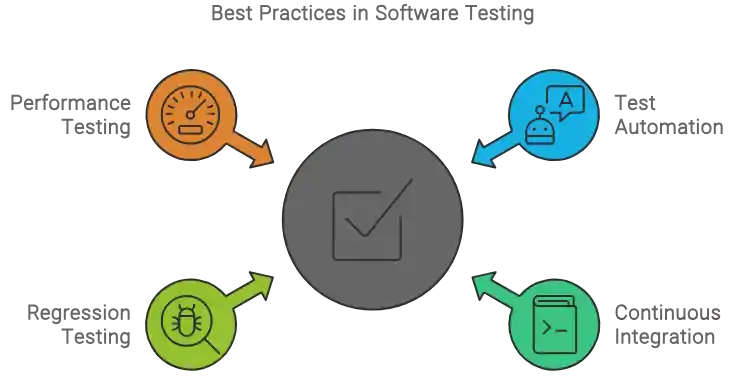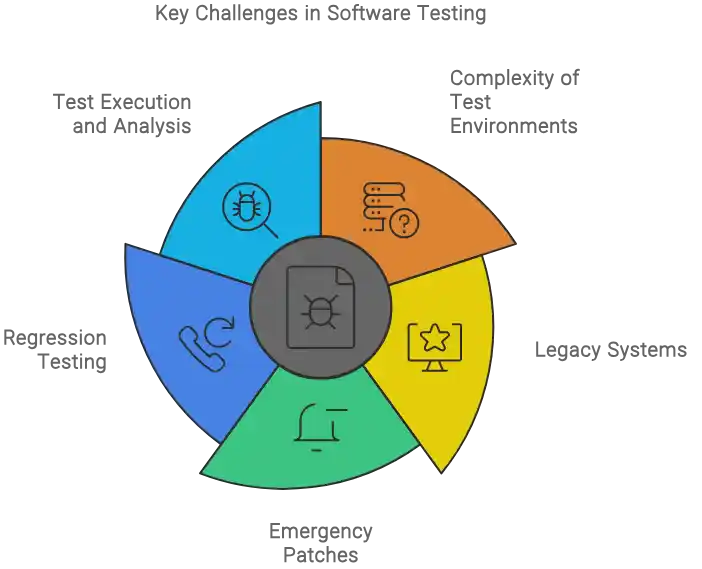Table of Contents
In today’s fast-paced software development environment, application quality and stability are more important than ever. The Software Testing Life Cycle (STLC) serves as a structured framework that guides the testing process, ensuring that software products meet the required standards and fulfill user expectations.
STLC encompasses a series of well-defined phases, each with specific objectives and deliverables, which collectively contribute to the overall quality assurance of software applications.
The importance of STLC cannot be overstated, as it not only helps in identifying defects early in the development process but also facilitates compliance with industry standards and regulations.
This is particularly vital in sectors such as healthcare, finance, and aerospace, where software reliability is paramount. By adhering to the STLC, organizations can enhance their development processes, tools, and frameworks, leading to continuous improvement and higher customer satisfaction.
This comprehensive beginner’s guide aims to demystify the Software Testing Life Cycle by breaking down its phases, methodologies, and significance. We will explore how each phase contributes to the overall testing process, the methodologies employed, and the benefits of implementing a robust STLC.
Whether you are a novice in the field of software testing or looking to refresh your knowledge, this guide will provide you with the foundational understanding necessary to navigate the complexities of software testing effectively.
Join us as we delve into the intricacies of the Software Testing Life Cycle, equipping you with the knowledge to ensure that your software products are not only functional but also reliable and of the highest quality.
Understanding Entry and Exit Criteria in STLC
Entry and exit criteria are essential components of the Software Testing Life Cycle (STLC) that help ensure the testing process is effective and efficient. Here’s a detailed explanation of both concepts:
Entry Criteria:
Entry criteria are the conditions that must be met before the testing phase can begin. They ensure that the testing environment is ready and that all necessary preparations have been completed.
These criteria typically include:
- Availability of all required documents, such as the test plan, requirement specifications, and design documents.
- Completion of the development phase, ensuring that the software is stable enough for testing.
- A clear understanding of the application flow and user requirements, which is crucial for creating effective test cases.
For example, before starting the creation of test cases, the QA team must have access to the user requirements document and a complete understanding of the application flow.
Exit Criteria:
Exit criteria define the conditions that must be satisfied before concluding a testing phase. They ensure that the testing process has been thorough and that the software meets the quality standards.
Common exit criteria include:
- Completion of all planned test cases and execution of tests.
- Resolution of all critical defects identified during testing.
- Confirmation that the software meets the specified requirements and is free of major defects.
Ideally, the QA team should not proceed to the next testing stage until all exit criteria for the current stage are met, ensuring a systematic approach to testing.
Importance of Entry and Exit Criteria:
Both entry and exit criteria are vital for maintaining the quality of the testing process. They help in:
- Ensuring that testing is conducted in a structured manner.
- Reducing the risk of defects in the final product by ensuring thorough testing.
- Providing a clear framework for the QA team to follow, which enhances accountability and traceability throughout the testing process.
In summary, entry and exit criteria are fundamental to the STLC, guiding the QA team in their testing efforts and ensuring that the software product is of high quality and meets user expectations.
Software Testing Life Cycle (STLC)
So, What is the Software Testing Life Cycle? The Software Testing Life Cycle (STLC) is a systematic process that outlines the various stages involved in software testing. It ensures that the software application is thoroughly tested to meet the specified requirements and is free from defects.
STLC provides a structured approach to testing, which helps in delivering high-quality software products that align with customer expectations and industry standards.

Phases of STLC
Each phase of STLC has specific objectives and deliverables, contributing to the overall effectiveness of the testing process.
1. Requirement Analysis
Requirement analysis is a critical phase in the software development process that focuses on gathering and understanding the needs of stakeholders. This involves conducting thorough market research and user surveys to identify the target audience and their preferences, ensuring that the final product aligns with user expectations.
During this phase, it is essential to clarify and document both functional and non-functional requirements, which serve as the foundation for the development team.
By engaging with stakeholders, the team can identify any gaps or loopholes in the specifications, allowing for a more comprehensive understanding of what is needed.
This collaborative approach not only helps in defining clear requirements but also ensures that every aspect of the project is aligned with the business goals, ultimately leading to a more successful outcome
2. Test Planning
Test planning is a vital phase in the software testing life cycle where a comprehensive test plan is created to guide the testing process. This plan outlines the scope and objectives of testing, ensuring that all necessary aspects are covered.
The QA team begins by analyzing the requirements and product domain to define what needs to be tested and the goals of the testing efforts. They identify the types of testing to be performed, such as functional, usability, and performance testing, and decide on the testing approaches, which may include both manual and automated methods.
Additionally, the test plan specifies the roles and responsibilities of team members, the necessary testing tools, and the testing environment, which helps in organizing the testing activities effectively.
By clearly defining the test scope and objectives, the team can ensure that the testing aligns with the overall project goals and stakeholder expectations, ultimately leading to a more efficient and successful testing process.
3. Test Case Development
Test case development is a critical process in software testing that involves designing and writing test cases to ensure comprehensive coverage of the software’s functionality.
This process begins with defining the test scenarios, which include the inputs, expected outputs, and the conditions under which the tests will be executed. Testers must create detailed test cases that are clear and understandable, allowing any team member to execute them effectively.
Once the test cases are established, the next step is to write automated test scripts, which can enhance efficiency and reduce manual effort in testing. These scripts are often developed using tools like Selenium, enabling the automation of repetitive testing tasks, such as regression testing and compatibility checks across different platforms.
Ultimately, the goal of this development phase is to produce organized test suites that can be executed systematically, ensuring that all functionalities are validated against the requirements
4. Test Environment Setup
Test environment setup is a vital phase in the software testing life cycle that involves preparing the necessary environment for testing activities. This process begins with identifying the hardware, software, network configurations, and data required to replicate the production environment effectively.
Testers must ensure that the test environment aligns with the user environments, which may include various operating systems and devices, to cover all potential user scenarios. Once the environment is prepared, the next step is configuring the testing tools and resources.
This includes deploying testing tools like Selenium or Katalon Studio, integrating them with the development environment, and ensuring that all necessary drivers and software are installed.
Additionally, collaboration with Salesforce DevOps and system administrators may be necessary to address any support needs during this setup phase. Ultimately, a well-prepared test environment is crucial for executing effective and efficient testing, leading to more reliable software products.
5. Test Execution
Test execution is a critical phase in the software testing life cycle where testers run predefined test cases to evaluate the software’s functionality.
During this phase, the testing team meticulously executes the test cases as outlined in the test plan, comparing the actual outcomes with the expected results. If discrepancies arise, they document these as defects, providing detailed reports that include steps to reproduce the issue, severity, and any relevant screenshots or logs.
This process not only helps in identifying bugs but also ensures that the software meets its requirements and performs as intended. Once defects are reported, they are communicated to the development team for resolution.
After fixes are implemented, the testing team retests the affected areas to confirm that the issues have been resolved and that no new defects have emerged as a result of the changes.
This cycle of executing tests, reporting defects, and retesting is essential for maintaining software quality and reliability throughout the development process.
6. Test Closure
Test closure is the final phase of the software testing life cycle, where the testing team analyzes the results of the testing activities and documents the lessons learned throughout the process.
This stage involves generating a comprehensive test closure report that summarizes all testing activities, outcomes, and any defects identified during the testing cycle. The report serves as a valuable resource for stakeholders, providing insights into the quality of the software and areas for improvement.
Additionally, the team reflects on the testing process, identifying what worked well and what could be enhanced in future projects. This documentation of lessons learned is crucial for continuous improvement, as it helps in refining testing strategies and methodologies for subsequent projects.
By thoroughly analyzing test results and capturing insights, organizations can enhance their testing processes and ultimately deliver higher-quality software products.
By following these phases, organizations can ensure a comprehensive and effective testing process that enhances software quality and reliability.
Key Differences Between STLC and SDLC
| Aspect | Software Development Life Cycle (SDLC) | Software Testing Life Cycle (STLC) |
| Definition | A framework that outlines the stages of software development from planning to deployment. | A subset of SDLC focused specifically on the testing phases of the software. |
| Phases | Includes phases like requirement analysis, design, implementation, testing, deployment, and maintenance. | Consists of phases such as Test Planning, Test Analysis, Test Design, Test Environment Setup, Test Execution, Test Closure, and Defect Retesting. |
| Focus | Concentrates on the overall development process and delivering a functional software product. | Concentrates on ensuring the quality of the software through systematic testing. |
| Objectives | Aims to develop a software product that meets user requirements and is delivered on time. | Aims to identify defects and ensure that the software meets quality standards before release. |
| Entry and Exit Criteria | Defines entry and exit criteria for the overall development process. | Has specific entry and exit criteria for each testing phase to ensure thorough testing. |
| Interrelation | STLC is part of the SDLC, indicating that testing is integrated into the development process. | STLC phases often overlap with SDLC phases, particularly during the testing phase, highlighting their interdependence. |
| Deliverables | Produces deliverables like software requirements specifications, design documents, and the final software product. | Produces deliverables such as test plans, test cases, test scripts, and defect reports. |
| Quality Assurance | Quality assurance is a broader concept that encompasses the entire development process. | Quality assurance is specifically focused on the testing activities to ensure the software is defect-free. |
Understanding the differences between the Software Development Life Cycle and Software Testing Life Cycle is essential for effective software development and quality assurance. Here are the key distinctions:
Definition:
- STLC: The STLC is a series of phases specifically focused on testing the software to ensure its quality and functionality. It encompasses activities that occur after the development phase to validate the software product.
- SDLC: The SDLC is a broader framework that outlines the entire process of software development, from initial planning and requirements gathering to deployment and maintenance. It includes all stages of software creation, including design, coding, and testing.
Phases:
- STLC Phases: The STLC consists of specific phases such as Planning, Analysis, Design, Execution, Closure, and Defect Retesting, which are solely dedicated to testing activities.
- SDLC Phases: The SDLC includes phases like Requirement Analysis, Design, Implementation, Testing, Deployment, and Maintenance, covering the complete lifecycle of software development.
Focus:
- STLC Focus: The primary focus of STLC is on ensuring the quality of the software product through rigorous testing. It aims to identify defects and ensure that the software meets the specified requirements.
- SDLC Focus: The SDLC focuses on the overall development process, ensuring that the software is built according to user requirements and is delivered on time and within budget.
Interrelation:
- STLC and SDLC Relationship: The STLC is a subset of the SDLC, meaning that testing is an integral part of the overall development process. The two cycles are interconnected, with testing activities occurring at various stages of the SDLC.
Outcome:
- STLC Outcome: The outcome of the STLC is a validated and verified software product that is ready for deployment, ensuring that it meets quality standards and user expectations.
- SDLC Outcome: The outcome of the SDLC is a fully developed software application that is functional, meets user requirements, and is ready for release to the market.
By understanding these differences, teams can better integrate testing into the development process, ensuring high-quality software delivery.
Best Practices in Software Testing

Implementing best practices in software testing is crucial for ensuring high-quality software products.
- Test Automation: Automating repetitive test cases can significantly enhance efficiency and accuracy, allowing testers to focus on more complex scenarios. This practice helps in executing tests faster and more consistently, reducing human error .
- Continuous Integration: Integrating testing into the development process through continuous integration ensures that tests are run automatically with every code change. This approach helps in identifying defects early, leading to quicker resolutions and a more stable product .
- Regression Testing: Regularly performing regression testing is essential to ensure that new code changes do not adversely affect existing functionalities. This practice helps maintain software reliability and user satisfaction by catching issues that may arise from updates .
- Performance Testing: Conducting performance testing is vital to assess how the software behaves under various conditions, such as high load or stress. This practice ensures that the application can handle expected user traffic and performs efficiently, which is particularly important in industries where reliability is critical .
By adhering to these best practices, teams can improve collaboration, reduce risks, and enhance the overall quality of their software products.
Challenges in Software Testing

Software testing is a critical phase in the software development lifecycle, but it comes with several challenges that can impact the quality and efficiency of the testing process.
- Complexity of Test Environments: Setting up the right test environment is essential for effective testing. Without the necessary servers, frameworks, hardware, and software, testers may struggle to execute test cases properly. This complexity can lead to unresolved bugs and undetected issues, making it difficult to ensure software quality.
- Legacy Systems: Testing legacy systems can be particularly challenging as they may require outdated tools or manual testing approaches. This situation often necessitates a different testing strategy, which can complicate the overall testing process and increase the risk of errors.
- Emergency Patches: In scenarios where critical issues arise, the testing team may need to bypass standard testing phases to quickly implement emergency patches. This urgency can lead to insufficient testing, increasing the likelihood of defects slipping through to production.
- Regression Testing: As software evolves, regression testing becomes crucial to ensure that new changes do not disrupt existing functionalities. However, managing regression tests can be challenging, especially if the test suite is not well-organized. Unresolved bugs or skipped tests due to tight deadlines can further complicate this process.
- Test Execution and Analysis: During the test execution phase, analyzing results and identifying defects can be time-consuming. Testers must ensure that all issues are reported accurately to the development team for resolution, which can be difficult if the testing process lacks organization.
By understanding and addressing these challenges, teams can improve their testing processes and enhance the overall quality of their software products.
Conclusion
In summary, the Software Testing Life Cycle (STLC) is a systematic approach that plays a crucial role in ensuring software quality. It consists of several phases, including Planning, Analysis, Environment Setup, Execution, Closure, and Defect Retesting.
Each phase has specific objectives and deliverables, which help in delivering a reliable and bug-free application that meets user requirements .
Key points to remember include:
- Phases of STLC: Each phase is designed to address specific aspects of testing, ensuring thorough coverage and quality assurance.
- Importance of STLC: Following the STLC helps organizations release high-quality software that meets customer needs, ultimately leading to customer satisfaction and business success .
- Link to SDLC: The STLC is closely linked to the Software Development Life Cycle (SDLC), with some phases overlapping, emphasizing the importance of testing throughout the development process .
Importance of Following STLC
Adhering to the STLC is vital for several reasons:
- Quality Assurance: It ensures that the software is tested systematically, reducing the chances of defects and enhancing overall quality .
- Structured Approach: A structured testing process allows for better planning, execution, and tracking of testing activities, leading to more efficient use of resources .
- Risk Mitigation: By following the STLC, organizations can identify and address potential issues early in the development process, minimizing risks associated with software failures .
Future Trends in Software Testing
Looking ahead, several trends are likely to shape the future of software testing:
- Automation: The increasing adoption of automation tools will streamline testing processes, allowing for faster execution and more comprehensive coverage of test cases.
- AI and Machine Learning: The integration of AI and machine learning in testing will enhance defect detection and prediction, making testing more efficient and effective.
- Continuous Testing: As organizations move towards DevOps and Agile methodologies, continuous testing will become essential, ensuring that testing is integrated throughout the development lifecycle.
By embracing these trends and adhering to the STLC, organizations can enhance their software testing processes and deliver high-quality applications that meet the evolving needs of users.





